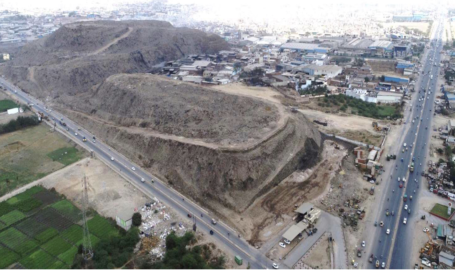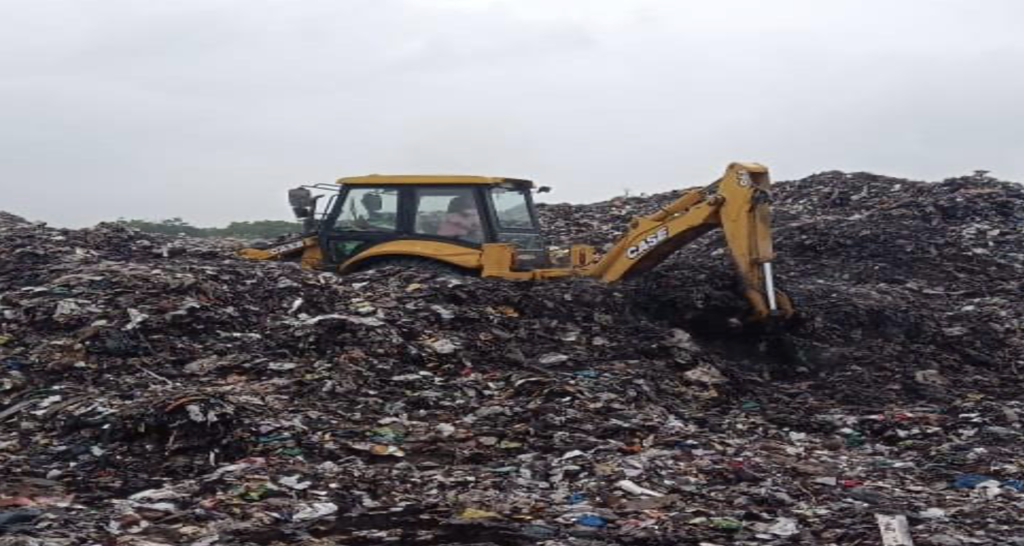
Waste at Ahmedabad’s massive Pirana landfill is being cleared through biomining
For the Ahmedabad Municipal Corporation, improving the environment, restoring nature and maintaining cleanliness has become a prime focus. Since 2019, more than 33,000 square meters of land have been converted from waste dumpsite to ecology parks. This includes:
- Transformation of Pirana wherein approximately 50 percent of the dumpsite has been bio-mined. As of today, a total of 44 Lakh MT of legacy waste has been processed and 24 acres of valuable land reclaimed out of 84 acres.
- Transformation of Bopal waste dumping site into an imposing 8000 sq m of ecology park after processing more than 3 lakh tons of waste.
This transformation would not have been possible without strong determination, vision, leadership, focus and urge for change. SolidWasteIndia’s Editor-in-Chief Aafrin Kidwai spoke with Mr Mukesh Kumar, Municipal Commissioner, Ahmedabad City regarding how the project was designed and implemented.

Q1. What was the transformative vision behind these biomining projects?
The Ahmedabad Municipal Corporation (AMC) is on a mission to reconnect nature with humanity. Ahmedabad city has been constantly reinventing newer ways of making the city cleaner, greener, vibrant and more liveable using cutting edge technologies and modern science. Transforming the waste lands into flourishing green spaces has been one of the key tenets of AMC’s urban rejuvenation program. As a result, we have been able to transform more than 85 acres of land into blooming ecology parks. More of such initiatives will follow.
Q2. What are the benefits of biomining as compared to other landfill treatment methods?
The solid waste is a complex mix of plastic, soil, construction waste, etc and hence it needs to be segregated and transformed. Biomining is a process whereby previously dumped waste is dug up after loosening by harrowing and then processed to recover valuable recyclable scrap while also recovering landfill space. Th biomining process extract materials of economic interest from legacy waste and the end product, likely to be soil, is rid of toxic materials and hence becomes reusable. The bio-mining process has been successfully applied to the legacy waste to extract plastic (RDF), soil, semi-compost and construction and demolition (C&D) waste.
Q3. Could you describe, in detail, the biomining process followed by the AMC?
Biomining is done in three phases: Phase 1: Stabilization – In this phase, the legacy waste is dried and made ready for screening by reducing moisture, eliminating pathogens, removing stench, harmful gases, generating biological heat and decomposing the waste to water and CO2 using a technique called bioremediation.
Phase 2: Sorting and segregation – In this phase, excavated landfill waste that is stabilized is separated to collect soil, stones and combustibles. Series of trommels and manpower is used to segregate the aggregates and other heavy construction waste and debris.
Phase 3: Disposal – In this phase, the non-combustible fractions such as soil and stones are disposed of for further processing into finer aggregates or for earth filling. The combustible fractions are called refuse- derived fuel (RDF) and are in general sent for co-processing in cement industries.
Biomining is a low-cost solution compared to capping to remove the garbage hills and their lingering ill effects. It achieves permanent near-zero emission of harmful gases (such as methane, hydrogen sulphide and ammonia) and leachate.

Q4. What makes this biomining project so unique as compared to other biomining projects?
In my opinion, this project standouts from the rest in many ways:
➢ Meticulous planning – From inception to the end, each step was carefully planned, best of the technologies were evaluated and chosen, key performance criterion’s (KPI’s) were derived, a focused team was formed, and detailed evaluation matrix to ensure qualitative and timely execution of the project was formulated.
➢ Massive parallel execution – With quality, speed of execution was also a predominant aspect. Post the success of the pilot, multiple trommel machines were deployed for simultaneously processing the legacy waste swiftly. As of today, 51 trommels having a processing capacity of 300 TPD each and 9 machines of 1000 TPD capacity are installed at the site which are currently processing more than 16000 TPD of legacy waste every day.
➢ Team work and support – AMC and vendors’ teams have worked very closely to deliver the results. Along with the vendor, Team AMC has been working round the clock and providing all the necessary support and a conducive ecosystem for the vendors so they can perform to the optimal. AMC has also provided requisite infrastructure by constructing RCC platforms along with electricity connections, 50 JCBs, 65 excavators, 150 trucks and proper sanitation facilities and logistics for the transmission of waste, during the process. Every effort was made by team AMC to ensure the work continues unabated.
➢ Operating Model – Our project economics and “Rental Model” we developed are precise and the projects remains more economical as compared to similar projects in the other cities.
➢ Employment – This project has created employment opportunities for 500-plus workers and made them self-reliant.
We recommend biomining to other ULBs and are very keen to share our learnings and help them with their transformation projects.
Mr Mukesh Kumar, Municipal Commissioner, Ahmedabad City
Q5. In your opinion, what are some of the factors that contributed to the success of this massive project?
The challenge was to transform the existing 1.25 crore MT legacy waste that is lying at Pirana and about 3 lakh tones of waste lying at Bopal Dump Site. Processing such heaps of waste was a mammoth task for the Solid Waste Management (SWM) Department of AMC. Despite the odds, the SWM Department took up the massive exercise of this significant transformation. Following were some of the key activities which resulted in our success:
➢ Study of similar projects – Before embarking on the project, AMC studied the tenders and projects of other cities and narrowed down the technologies to be used. An operating model for the project was then developed. Post this, a pilot study was carried out at one of the heaps at Ajmeri Dump site with 2 trommel machines.
➢ Faster Procurement – After studying the other projects and tenders and taking the learnings from the pilot exercise, AMC soon came out with its tenders and onboarded vendor/s to execute the projects at an aggressive pace.
➢ Strategic Focus – After the success of the pilot, the site was divided into multiple zones and with each zone having dedicated machines and target date of completion. Hence the worked was performed with massive parallel processing.
➢ Project management – Our team followed a very focused project management approach which ensured regular monitoring, proper feedback mechanism and faster problem resolution. This ensured that the project never took a back seat and always adhered to the timelines.
➢ Pre-emptive Maintenance – Regular and timely maintenance ensured that all the machines were up and running most of the time, which resulted in higher productivity.
All the above factors, in my opinion, resulted in the successful transformation.

Q6. What are the plans for the next phase, wherein all the waste will be cleared?
100 percent of the Bopal dumpsite and nearly 50 percent of the Pirana dumpsite has already been transformed. Our team has now become both experienced and efficient in such projects. Plans for the future include expediting removal of the rest of the heaps at Pirana by installing more machines and faster recovery 100 percent of the land.
AMC is planning to use recovered land for setting up of an Oxygen Park or Ecological Park, which will prove to be immensely beneficial for our citizens.
Q7. What has been done with the segregated plastic waste and other non-biodegradables?
During the biomining process the major resources extracted from legacy waste are plastic, soil, semi-compost, and construction and demolition (C&D) waste. The non-combustible fractions such as soil and semi-compost are used for earth-filling while the inert and C&D waste obtained is being used in various development projects across the city. The combustible fractions called refuse-derived fuel (RDF) are sent to waste to energy plants (WtE) and for co-processing in cement industries.
Q8. How did the AMC finance this project?
Both, the Pirana and Bopal projects are primarily being funded by the AMC, which has provisioned approximately Rs 100 crore in its annual budget for them. Further, a grant allotted by SBM Govt of Gujarat is also being used for the project.
Q9. What were some of the challenges faced in the process?
One major challenges was the disposal of biomined waste. During the biomining process large quantities of C&D, inert/raw dust and RDF type of waste were generated. Quick disposal of these wastes has been a challenge. As a result, AMC has started using RDF waste to make paver blocks, manhole cover etc. We are also using raw dust/inert to fill the low-lying areas, like the east side of the riverfront at Dudheshwar.
Maintenance of machines and equipment was another challenge. With the machines are working at their optimum capacity relentlessly, it requires tremendous efforts to ensure that they run efficiently all the time. Hence, AMC organizes regular machine checkups and preventive maintenance camps to ensure best of health for the machines and equipment.
Q10. Would you recommend biomining to other ULBs dealing with large volumes of legacy waste?
Yes, absolutely. We recommend biomining to other ULB’s and are very keen to share our learnings and help them on their transformation projects.
In 2019, even the The Hon’ble National Green Tribunal instructed (OANo. 606 of 2018 on 26.03.2019) recommended that “Dump sites should not simply be capped but should be bio- mined, materials should be recovered, land should be reclaimed, and should be maintained in accordance with SWM rules 2016”.
AMC has proven biomining to be a successful and an economical model in processing legacy waste, especially of tremendously large volumes. This has resulted in the creation of employment opportunities for people and resulted in a healthy environment. With such projects, AMC has been able to make an impact on environmental as well as on social level. Considering this, we highly recommend biomining to other cities and ULBs.

Q11. Will Pirana continue to be a dumpsite after this is cleared? Are you still dumping waste at the site?
Processing of such stupendous waste is a time-consuming process, especially when tons of waste gets added every day. The Bopal dump site has already become waste-free. For Pirana, AMC has charted a roadmap wherein required infrastructure and adequate logistical support will be provided to ensure that Pirana becomes waste-free in a few years.
Considering the current waste volume and anticipating the future waste volumes of future AMC has following strategic plans to make Pirana waste-free:
- Operationalize 1000 TPD Compost Plants, 100 TPD automated MRF with 8 de-centralized MRF near Refuse Transfer Station for all seven zones. All of these are institutionalized and in operation.
- Coming up with two WtE plants with a total capacity of 2000 TPD waste. Work has already been awarded for these. These plants will generate total 28 MW electricity, out of which one plant will start operations in 2022.
- Coming up with a Plastic Waste Management facility with a capacity of 150 TPD each for collection and treatment of plastic waste. The work has already been awarded for the same.



